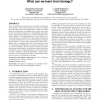Free Online Productivity Tools
i2Speak
i2Symbol
i2OCR
iTex2Img
iWeb2Print
iWeb2Shot
i2Type
iPdf2Split
iPdf2Merge
i2Bopomofo
i2Arabic
i2Style
i2Image
i2PDF
iLatex2Rtf
Sci2ools
CCR
2010
2010
Evolvable network architectures: what can we learn from biology?
There is significant research interest recently to understand the evolution of the current Internet, as well as to design clean-slate Future Internet architectures. Clearly, even when network architectures are designed from scratch, they have to evolve as their environment (i.e., technological constraints, service requirements, applications, economic conditions, etc) always changes. A key question then is: what makes a network architecture evolvable? What determines the ability of a network architecture to evolve as its environment changes? In this paper, we review some relevant ideas about evolvability from the biological literature. We examine the role of robustness and modularity in evolution, and their relation with evolvability. We also discuss evolutionary kernels and punctuated equilibria, two important concepts that may be relevant to the so-called ossification of the core Internet protocols. Finally, we examine optimality, a design objective that is often of primary interest ...
| Added | 09 Dec 2010 |
| Updated | 09 Dec 2010 |
| Type | Journal |
| Year | 2010 |
| Where | CCR |
| Authors | Constantine Dovrolis, J. Todd Streelman |
Comments (0)

